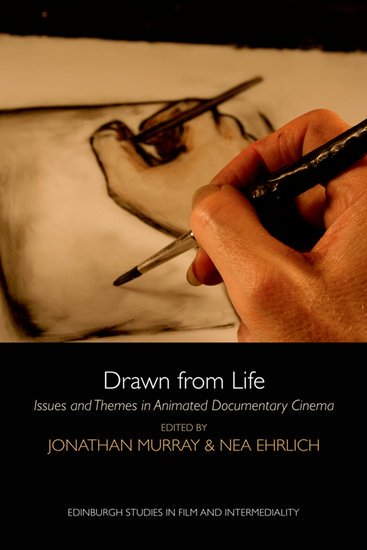Review of Nea Ehrlich and Jonathan Murray (eds.). Drawn from Life: Issues and Themes in Animated Documentary Cinema. Edinburgh: Edinburgh University Press, 2019.

This book project evolved from a collection of proceedings during a 2011 conference held at Edinburgh University called Animated Realities. The conference concept hoped to collect both theorists and producers of animation documentaries to consider the aesthetic and philosophical use of animation in producing a documentary.
Throughout my history of experience with creating media (both animation and documentary) the lack of reliable definitions of both “animation” and “documentary” have fascinated me as a participant and, most importantly, as a teacher. Ehrlich and Murray’s book indicates my fascination is shared by others involved in these two fields and any combination of both. Indeed, the thirteen chapters of Animated Realities, plus the definitive introduction by the editors, provide the basis for constructive consideration and advanced research on this fascinating topic.
The chapters contain discussions on the variety of experimenting on production and the understanding of animation documentary. Each chapter approaches the topic by analyzing production techniques. These include stop-motion with puppets, modified drawings, single frame, collages, cut-outs, reenactment via drawings, mixed drawings plus live action, and animatics. Also covered are a variety of individual means of documentary strategies: expository, participatory, penetrative, educational, edutainment, and performative. Each of these strategies is discussed in more than one chapter to give the reader a deep understanding of the different techniques and their applications to the animation documentary process.

The history of film, animation and documentary appears in several chapters. This reveals that much research still needs to be considered before making an absolute determination of what can be called “animation documentary”. Examples of variations of this form include Sinking of the Lusitania (1918), Waltz with Bashir (2008), Children of the Holocaust (2003) , Truth Has Fallen (2013) and many others. These productions are analyzed to determine their standing as an animation documentary. Most importantly, it is explained how each was produced to meet the essential criteria of that media format.
Having worked in professional media news operations, I was pleased to read the discussions in several of the chapters highlighting one key problem with documentaries in any form: what is truth? This question also encompasses the effect of memory on documentary. Other chapters consider the so-called “new journalism”, detailed biographies, mockumentaries, docudramas, and entertainment “news” shows, such as The Daily Show, or websites, such as The Guardian, and how these works relate in composition and production to animation documentaries.
In conclusion, the work of the editors and chapter authors provides a valuable collection of information, philosophical thought and production considerations that every animation teacher, researcher and practitioner need to read and have handy. It will serve as a reference and provide guidance for their own investigation as well as for that of their students.
Robert Musburger is the CFO of the Society for Animation Studies. He retired as Director of the School of Communication of the University of Houston in 2003 as a Professor Emeritus. He taught media production, writing and animation at Avila College, University of Missouri-Kansas City, University of Kansas, Florida State University, University of Houston and Central Washington State University. He published five textbooks on media production and animation with translations in Spanish, Portuguese, Mandarin, and Russian plus a variety of chapters, journal articles, and reviews.
